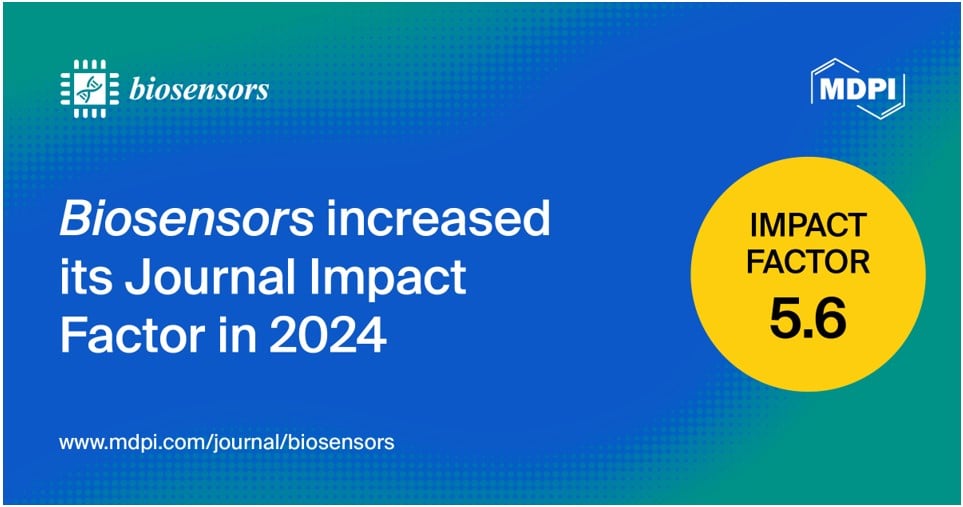Journal Description
Biosensors
Biosensors
is an international, peer-reviewed, open access journal on the technology and science of biosensors published monthly online by MDPI.
- Open Access— free for readers, with article processing charges (APC) paid by authors or their institutions.
- High Visibility: indexed within Scopus, SCIE (Web of Science), PubMed, MEDLINE, PMC, Embase, CAPlus / SciFinder, Inspec, and other databases.
- Journal Rank: JCR - Q1 (Instruments and Instrumentation) / CiteScore - Q1 (Instrumentation)
- Rapid Publication: manuscripts are peer-reviewed and a first decision is provided to authors approximately 21.8 days after submission; acceptance to publication is undertaken in 2.8 days (median values for papers published in this journal in the first half of 2025).
- Recognition of Reviewers: reviewers who provide timely, thorough peer-review reports receive vouchers entitling them to a discount on the APC of their next publication in any MDPI journal, in appreciation of the work done.
Impact Factor:
5.6 (2024);
5-Year Impact Factor:
5.7 (2024)
Latest Articles
Measurement of Salivary Cortisol for Revealing Age-Specific Dependence of Cortisol Levels on Time, Feeding, and Oxygen Metabolism in Newborn Infants
Biosensors 2025, 15(7), 420; https://doi.org/10.3390/bios15070420 - 1 Jul 2025
Abstract
Salivary cortisol is widely used to assess stress and circadian rhythms, yet its control variables in neonates, particularly regarding postnatal age, remain poorly understood. To elucidate age-specific effects of clinical variables on cortisol levels, 91 neonates with a mean (standard deviation) gestational age
[...] Read more.
Salivary cortisol is widely used to assess stress and circadian rhythms, yet its control variables in neonates, particularly regarding postnatal age, remain poorly understood. To elucidate age-specific effects of clinical variables on cortisol levels, 91 neonates with a mean (standard deviation) gestational age of 34.2 (3.8) weeks and postnatal age of 38.3 (35.4) days were categorised into Early, Medium, and Late groups by quartiles (days 10 and 56). Interactions with postnatal age were evaluated by comparing Early-to-Medium or Early-to-Late differences in regression coefficients between independent variables and cortisol levels. In the whole cohort, maternal hypertensive disorders of pregnancy and morning sampling were associated with reduced cortisol levels (both p = 0.001). Mean regression coefficients (95% CI) between variables and cortisol levels were as follows: for postconceptional age, Early, −0.102 (−0.215, 0.010) and Late, 0.065 (−0.203, 0.332) (p = 0.035); for feeding duration, Early, 0.796 (−0.134, 1.727) and Late, −0.702 (−2.778, 1.376) (p = 0.010); for time elapsed since feeding, Early, −0.748 (−1.275, −0.221) and Late, −0.071 (−1.230, 1.088) (p = 0.036); and for blood lactate, Early, 0.086 (0.048 to 0.124), Medium, 0.022 (−0.063, 0.108), and Late, −0.018 (−0.106, 0.070) (p = 0.008 and <0.001 vs. Medium and Late, respectively). The influence of postconceptional age, oral feeding, and anaerobic metabolism on salivary cortisol levels was observed during the birth transition period but not beyond 10 days of life. Given the age-specific dependence of cortisol levels on clinical variables, including postconceptional age, feeding, and oxygen metabolism, caution is warranted when interpreting findings from studies on salivary cortisol in newborn infants.
Full article
(This article belongs to the Section Biosensors and Healthcare)
►
Show Figures
Open AccessReview
Strategic Detection of Escherichia coli in the Poultry Industry: Food Safety Challenges, One Health Approaches, and Advances in Biosensor Technologies
by
Jacquline Risalvato, Alaa H. Sewid, Shigetoshi Eda, Richard W. Gerhold and Jie Jayne Wu
Biosensors 2025, 15(7), 419; https://doi.org/10.3390/bios15070419 - 1 Jul 2025
Abstract
Escherichia coli (E. coli) remains a major concern in poultry production due to its ability to incite foodborne illness and public health crisis, zoonotic potential, and the increasing prevalence of antibiotic-resistant strains. The contamination of poultry products with pathogenic E. coli
[...] Read more.
Escherichia coli (E. coli) remains a major concern in poultry production due to its ability to incite foodborne illness and public health crisis, zoonotic potential, and the increasing prevalence of antibiotic-resistant strains. The contamination of poultry products with pathogenic E. coli, including avian pathogenic E. coli (APEC) and Shiga toxin-producing E. coli (STEC), presents risks at multiple stages of the poultry production cycle. The stages affected by E. coli range from, but are not limited to, the hatcheries to grow-out operations, slaughterhouses, and retail markets. While traditional detection methods such as culture-based assays and polymerase chain reaction (PCR) are well-established for E. coli detection in the food supply chain, their time, cost, and high infrastructure demands limit their suitability for rapid and field-based surveillance—hindering the ability for effective cessation and handling of outbreaks. Biosensors have emerged as powerful diagnostic tools that offer rapid, sensitive, and cost-effective alternatives for E. coli detection across various stages of poultry development and processing where detection is needed. This review examines current biosensor technologies designed to detect bacterial biomarkers, toxins, antibiotic resistance genes, and host immune response indicators for E. coli. Emphasis is placed on field-deployable and point-of-care (POC) platforms capable of integrating into poultry production environments. In addition to enhancing early pathogen detection, biosensors support antimicrobial resistance monitoring, facilitate integration into Hazard Analysis Critical Control Points (HACCP) systems, and align with the One Health framework by improving both animal and public health outcomes. Their strategic implementation in slaughterhouse quality control and marketplace testing can significantly reduce contamination risk and strengthen traceability in the poultry value chain. As biosensor technology continues to evolve, its application in E. coli surveillance is poised to play a transformative role in sustainable poultry production and global food safety.
Full article
(This article belongs to the Special Issue Biosensors for Food Safety)
►▼
Show Figures
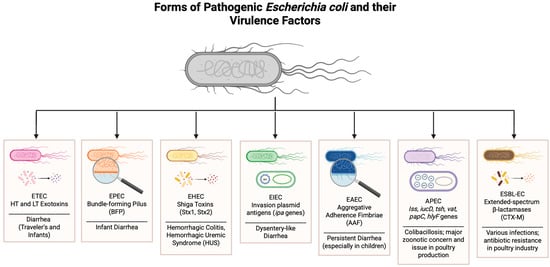
Figure 1
Open AccessArticle
Salivary Biosensing Opportunities for Predicting Cognitive and Physical Human Performance
by
Sara Anne Goring, Evan D. Gray, Eric L. Miller and Tad T. Brunyé
Biosensors 2025, 15(7), 418; https://doi.org/10.3390/bios15070418 - 1 Jul 2025
Abstract
Advancements in biosensing technologies have introduced opportunities for non-invasive, real-time monitoring of salivary biomarkers, enabling progress in fields ranging from personalized medicine to public health. Identifying and prioritizing the most critical analytes to measure in saliva is essential for estimating physiological status and
[...] Read more.
Advancements in biosensing technologies have introduced opportunities for non-invasive, real-time monitoring of salivary biomarkers, enabling progress in fields ranging from personalized medicine to public health. Identifying and prioritizing the most critical analytes to measure in saliva is essential for estimating physiological status and forecasting performance in applied contexts. This study examined the value of 12 salivary analytes, including hormones, metabolites, and enzymes, for predicting cognitive and physical performance outcomes in military personnel (N = 115) engaged in stressful laboratory and field tasks. We calculated a series of features to quantify time-series analyte data and applied multiple regression techniques, including Elastic Net, Partial Least Squares, and Random Forest regression, to evaluate their predictive utility for five outcomes of interest: the ability to move, shoot, communicate, navigate, and sustain performance under stress. Predictive performance was poor across all models, with R-squared values near zero and limited evidence that salivary analytes provided stable or meaningful performance predictions. While certain features (e.g., post-peak slopes and variance metrics) appeared more frequently than others, no individual analyte emerged as a reliable predictor. These results suggest that salivary biomarkers alone are unlikely to provide robust insights into cognitive and physical performance outcomes. Future research may benefit from combining salivary and other biosensor data with contextual variables to improve predictive accuracy in real-world settings.
Full article
(This article belongs to the Section Wearable Biosensors)
►▼
Show Figures
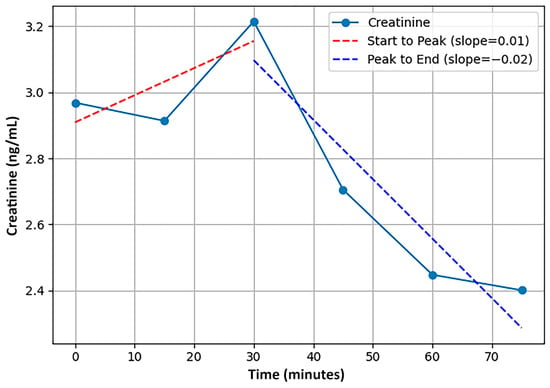
Figure 1
Open AccessArticle
Droplet-Based Measurements of DNA-Templated Nanoclusters—Towards Point-of-Care Applications
by
Jonas Kluitmann, Stefano Di Fiore, Greta Nölke and Klaus Stefan Drese
Biosensors 2025, 15(7), 417; https://doi.org/10.3390/bios15070417 - 1 Jul 2025
Abstract
In this work, we investigate the fundamental usability of fluorescent DNA-templated silver nanoclusters (DNA-AgNCs) as sensors for Point-of Care-Testing (PoCT) applications. We developed a microfluidic platform for the generation of droplets containing DNA-AgNCs in defined, different chemical environments. The droplets are read out
[...] Read more.
In this work, we investigate the fundamental usability of fluorescent DNA-templated silver nanoclusters (DNA-AgNCs) as sensors for Point-of Care-Testing (PoCT) applications. We developed a microfluidic platform for the generation of droplets containing DNA-AgNCs in defined, different chemical environments. The droplets are read out fluorescently at two different emission wavelengths. For the pre-evaluation for the usage of biologically relevant matrices with DNA-AgNCs, the response of two different DNA-AgNCs to a variation in pH and sodium chloride concentration was acquired. Our compact and simple setup can detect DNA-AgNCs well below 100 nM and allows the characterization of the fluorescence response of DNA-based biohybrid nanosensors to changes in the chemical environment within short measurement times. The model DNA-AgNCs remain fluorescent throughout the physiologically relevant chloride concentrations and up to 150 mM. Upon shifts in pH, the DNA-AgNCs showed a complex fluorescence intensity response. The model DNA-AgNCs differ strongly in their response characteristics to the applied changes in their environments. With our work, we show the feasibility of the use of DNA-AgNCs as sensors in a simple microfluidic setup that can be used as a building block for PoCT applications while highlighting challenges in their adaption for use with biologically relevant matrices.
Full article
(This article belongs to the Special Issue Lab-on-a-Chip Devices for Point-of-Care Diagnostics)
►▼
Show Figures
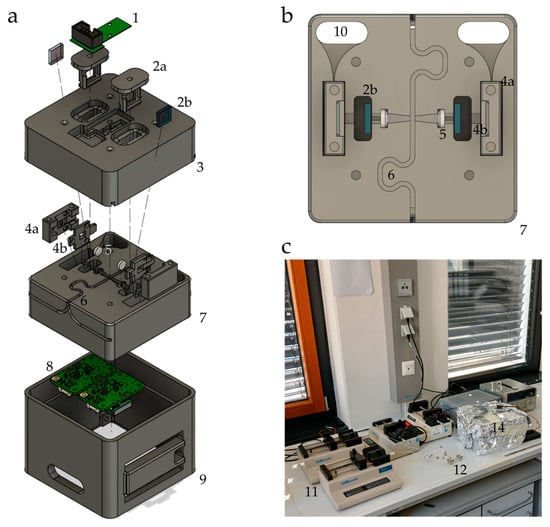
Figure 1
Open AccessEditorial
Photonics for Bioapplications: Sensors and Technology
by
Nélia Alberto, Maria Fátima Domingues, Nunzio Cennamo and Adriana Borriello
Biosensors 2025, 15(7), 416; https://doi.org/10.3390/bios15070416 - 1 Jul 2025
Abstract
Over the past decade, interest in advancing photonic systems for bioapplications has been steadily growing, and various key factors have driven this trend [...]
Full article
(This article belongs to the Special Issue Photonics for Bioapplications: Sensors and Technology)
Open AccessReview
Biosensing Strategies to Monitor Contaminants and Additives on Fish, Meat, Poultry, and Related Products
by
Zenebe Tadesse Tsegay, Elahesadat Hosseini, Teresa D’Amore, Slim Smaoui and Theodoros Varzakas
Biosensors 2025, 15(7), 415; https://doi.org/10.3390/bios15070415 - 30 Jun 2025
Abstract
Biosensors have emerged as highly sensitive, rapid, and specific tools for detecting food safety hazards, particularly in perishable products, such as fish, meat, and poultry. These products are susceptible to microbial contamination and often contain additives intended to improve shelf life and flavor,
[...] Read more.
Biosensors have emerged as highly sensitive, rapid, and specific tools for detecting food safety hazards, particularly in perishable products, such as fish, meat, and poultry. These products are susceptible to microbial contamination and often contain additives intended to improve shelf life and flavor, which may pose health risks to consumers. Recent advances in biosensor technologies integrated with smartphones, artificial sensing systems, 3D printing, and the Internet of Things (IoT) offer promising solutions for real-time monitoring. This review explores the types, mechanisms, standardization approaches, and validation processes of biosensors used to detect contaminants and additives in animal-based food products. Furthermore, the paper highlights current challenges, technical limitations, and future perspectives regarding the broader implementation of biosensors in modern food safety monitoring systems.
Full article
(This article belongs to the Special Issue Biosensing Strategies for Food Safety Applications)
►▼
Show Figures
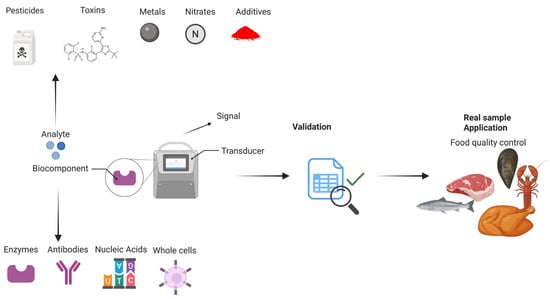
Figure 1
Open AccessArticle
Wearable Glove with Enhanced Sensitivity Based on Push–Pull Optical Fiber Sensor
by
Qi Xia, Xiaotong Zhang, Hongye Wang, Libo Yuan and Tingting Yuan
Biosensors 2025, 15(7), 414; https://doi.org/10.3390/bios15070414 - 27 Jun 2025
Abstract
Hand motion monitoring plays a vital role in medical rehabilitation, sports training, and human–computer interaction. High-sensitivity wearable biosensors are essential for accurate gesture recognition and precise motion analysis. In this work, we propose a high-sensitivity wearable glove based on a push–pull optical fiber
[...] Read more.
Hand motion monitoring plays a vital role in medical rehabilitation, sports training, and human–computer interaction. High-sensitivity wearable biosensors are essential for accurate gesture recognition and precise motion analysis. In this work, we propose a high-sensitivity wearable glove based on a push–pull optical fiber sensor, designed to enhance the sensitivity and accuracy of hand motion biosensing. The sensor employs diagonal core reflectors fabricated at the tip of a four-core fiber, which interconnect symmetric fiber channels to form a push–pull sensing mechanism. This mechanism induces opposite wavelength shifts in fiber Bragg gratings positioned symmetrically under bending, effectively decoupling temperature and strain effects while significantly enhancing bending sensitivity. Experimental results demonstrate superior bending-sensing performance, establishing a solid foundation for high-precision gesture recognition. The integrated wearable glove offers a compact, flexible structure and straightforward fabrication process, with promising applications in precision medicine, intelligent human–machine interaction, virtual reality, and continuous health monitoring.
Full article
(This article belongs to the Section Wearable Biosensors)
►▼
Show Figures

Graphical abstract
Open AccessArticle
A Novel Wearable Device for Continuous Blood Pressure Monitoring Utilizing Strain Gauge Technology
by
Justin P. McMurray, Aubrey DeVries, Kendall Frazee, Bailey Sizemore, Kimberly L. Branan, Richard Jennings and Gerard L. Coté
Biosensors 2025, 15(7), 413; https://doi.org/10.3390/bios15070413 - 27 Jun 2025
Abstract
Cardiovascular disease (CVD) is the leading cause of global mortality, with hypertension affecting over one billion people. Current noninvasive blood pressure (BP) systems, like cuffs, suffer from discomfort and placement errors and lack continuous monitoring. Wearable solutions promise improvements, but technologies like photoplethysmography
[...] Read more.
Cardiovascular disease (CVD) is the leading cause of global mortality, with hypertension affecting over one billion people. Current noninvasive blood pressure (BP) systems, like cuffs, suffer from discomfort and placement errors and lack continuous monitoring. Wearable solutions promise improvements, but technologies like photoplethysmography (PPG) and bioimpedance (BIOZ) face usability and clinical accuracy limitations. PPG is sensitive to skin tone and body mass index (BMI) variability, while BIOZ struggles with electrode contact and reusability. We present a novel, strain gauge-based wearable BP device that directly quantifies pressure via a dual transducer system, compensating for tissue deformation and external forces to enable continuous, accurate BP measurement. The reusable, energy-efficient, and compact design suits long-term daily use. A novel leg press protocol across 10 subjects (systolic: 71.04–241.42 mmHg, diastolic: 53.46–123.84 mmHg) validated its performance under dynamic conditions, achieving mean absolute errors of 2.45 ± 3.99 mmHg (systolic) and 1.59 ± 2.08 mmHg (diastolic). The device showed enhanced robustness compared to the Finapres, with less motion-induced noise. This technology significantly advances current methods by delivering continuous, real-time BP monitoring without reliance on electrodes, independent of skin tone, while maintaining a high accuracy and user comfort.
Full article
(This article belongs to the Special Issue Advances in Flexible Bioelectronics and Intelligent Biosensing Systems)
►▼
Show Figures

Figure 1
Open AccessArticle
Mechanically Tunable Composite Hydrogel for Multi-Gesture Motion Monitoring
by
Jiabing Zhang, Zilong He, Bin Shen, Jiang Li, Yongtao Tang, Shuhuai Pang, Xiaolin Tian, Shuang Wang and Fengyu Li
Biosensors 2025, 15(7), 412; https://doi.org/10.3390/bios15070412 - 27 Jun 2025
Abstract
Intrinsic conductive ionic hydrogels, endowed with excellent mechanical properties, hold significant promise for applications in wearable and implantable electronics. However, the complexity of exercise and athletics calls for mechanical tunability, facile processability and high conductivity of wearable sensors, which remains a persistent challenge.
[...] Read more.
Intrinsic conductive ionic hydrogels, endowed with excellent mechanical properties, hold significant promise for applications in wearable and implantable electronics. However, the complexity of exercise and athletics calls for mechanical tunability, facile processability and high conductivity of wearable sensors, which remains a persistent challenge. In this study, we developed a mechanically tunable and high ionic conductive hydrogel patch to approach multi-gesture or motion monitoring. Through adjustment of the ratio of amino trimethylene phosphonic acid (ATMP) and poly(vinyl alcohol) (PVA), the composite hydrogel attains tunable mechanical strength (varying from 50 kPa to 730 kPa), remarkable stretchability (reaching up to 1900% strain), high conductivity (measuring 15.43 S/m), and strong linear sensitivity (with a gauge factor of 2.34 within 100% strain). Benefitting with the tunable mechanical sensitivity, the composite hydrogel patch can perform subtle movement monitoring, such as epidermal pulses or pronounced muscle vibrations; meanwhile, it can also recognize and detect major motions, such as hand gestures. The mechanically tunable composite hydrogel contributes a versatile sensing platform for health or athletic monitoring, with wide and sensitive adoptability.
Full article
(This article belongs to the Special Issue Wearable Sensors for Precise Exercise Monitoring and Analysis)
►▼
Show Figures
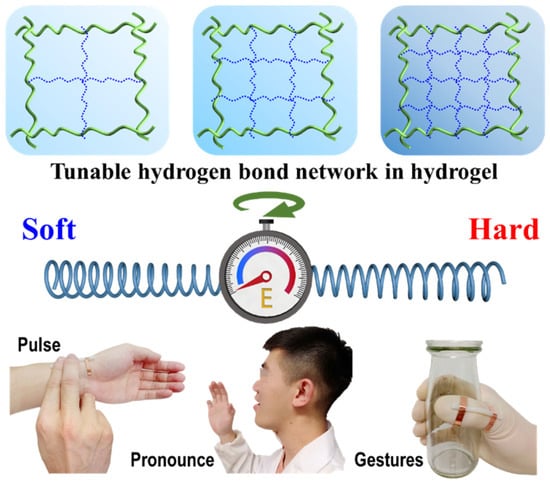
Figure 1
Open AccessArticle
Mn-Doped CeO2 Nanozyme-Integrated Mesoporous Interfaces for High-Sensitivity Antifouling Electrochemiluminescence Biosensing
by
Guanze Huang, Haiyan Qiu, Huiping Chen, Wanxuan Li, Yufei Zhang, Minfang Huang, Tingting Zhang, Xiaoxin Xu and Shanwen Hu
Biosensors 2025, 15(7), 411; https://doi.org/10.3390/bios15070411 - 27 Jun 2025
Abstract
To address the challenges of nonspecific adsorption interference and low mass transfer efficiency encountered by electrochemiluminescence (ECL) sensors in complex biological matrices, this study developed a Mn@CeO2 nanozyme-based sensing interface. The Mn-doped CeO2 enhanced electron transfer efficiency, increased oxygen vacancy concentration,
[...] Read more.
To address the challenges of nonspecific adsorption interference and low mass transfer efficiency encountered by electrochemiluminescence (ECL) sensors in complex biological matrices, this study developed a Mn@CeO2 nanozyme-based sensing interface. The Mn-doped CeO2 enhanced electron transfer efficiency, increased oxygen vacancy concentration, and stabilized the Mn-O-Ce structure, collectively enabling highly efficient peroxidase (POD)-like activity. The design significantly improved ECL reaction efficiency, which simultaneously conferred synergistic antifouling and mass transport enhancing properties. The mesoporous silica nanoparticle on the sensing interface accelerated mass transfer processes, thereby overcoming the limitations of traditional diffusion-controlled kinetics. The Mn@CeO2 nanozyme and mesoporous silica nanoparticle synergistically improved electron transfer and reactant enrichment, thereby significantly enhancing the signal response. Concurrently, a biomimetic anti-fouling coating was introduced at the interface to effectively suppress nonspecific adsorption of interferents. The constructed nanozyme-enhanced ECL sensing platform was demonstrated through the detection of dopamine (DA) as a model neurotransmitter, exhibiting favorable detection performance while maintaining high-accuracy detection in complex biological samples. This strategy offers a novel approach to developing highly sensitive and interference-resistant ECL sensors, with promising applications in disease biomarker monitoring and live physiological sample analysis.
Full article
(This article belongs to the Special Issue Biosensing and Diagnosis—2nd Edition)
►▼
Show Figures

Graphical abstract
Open AccessReview
AI-Driven Wearable Bioelectronics in Digital Healthcare
by
Guangqi Huang, Xiaofeng Chen and Caizhi Liao
Biosensors 2025, 15(7), 410; https://doi.org/10.3390/bios15070410 - 26 Jun 2025
Abstract
The integration of artificial intelligence (AI) with wearable bioelectronics is revolutionizing digital healthcare by enabling proactive, personalized, and data-driven medical solutions. These advanced devices, equipped with multimodal sensors and AI-powered analytics, facilitate real-time monitoring of physiological and biochemical parameters—such as cardiac activity, glucose
[...] Read more.
The integration of artificial intelligence (AI) with wearable bioelectronics is revolutionizing digital healthcare by enabling proactive, personalized, and data-driven medical solutions. These advanced devices, equipped with multimodal sensors and AI-powered analytics, facilitate real-time monitoring of physiological and biochemical parameters—such as cardiac activity, glucose levels, and biomarkers—allowing for early disease detection, chronic condition management, and precision therapeutics. By shifting healthcare from reactive to preventive paradigms, AI-driven wearables address critical challenges, including rising chronic disease burdens, aging populations, and healthcare accessibility gaps. However, their widespread adoption faces technical, ethical, and regulatory hurdles, such as data interoperability, privacy concerns, algorithmic bias, and the need for robust clinical validation. This review comprehensively examines the current state of AI-enhanced wearable bioelectronics, covering (1) foundational technologies in sensor design, AI algorithms, and energy-efficient hardware; (2) applications in continuous health monitoring, diagnostics, and personalized interventions; (3) key challenges in scalability, security, and regulatory compliance; and (4) future directions involving 5G, the IoT, and global standardization efforts. We highlight how these technologies could democratize healthcare through remote patient monitoring and resource optimization while emphasizing the imperative of interdisciplinary collaboration to ensure equitable, secure, and clinically impactful deployment. By synthesizing advancements and critical gaps, this review aims to guide researchers, clinicians, and policymakers toward responsible innovation in the next generation of digital healthcare.
Full article
(This article belongs to the Special Issue Wearable and Implantable Bioelectronics for Advanced Biosensing and Human Health Monitoring)
►▼
Show Figures

Figure 1
Open AccessReview
Recent Advances in Antibody Discovery Using Ultrahigh-Throughput Droplet Microfluidics: Challenges and Future Perspectives
by
Dhiman Das, John Scott McGrath, John Hudson Moore, Jason Gardner and Daniël Blom
Biosensors 2025, 15(7), 409; https://doi.org/10.3390/bios15070409 - 25 Jun 2025
Abstract
Droplet microfluidics has emerged as a transformative technology that can substantially increase the throughput of antibody “hit” discovery. This review provides a comprehensive overview of the recent advances in this dynamic field, focusing primarily on the technological and methodological innovations that have enhanced
[...] Read more.
Droplet microfluidics has emerged as a transformative technology that can substantially increase the throughput of antibody “hit” discovery. This review provides a comprehensive overview of the recent advances in this dynamic field, focusing primarily on the technological and methodological innovations that have enhanced the antibody discovery process. This investigation starts with the fundamental principles of droplet microfluidics, emphasizing its unique capabilities for precisely controlling and manipulating picoliter-volume droplets. This discussion extends to various assay types employed in droplet microfluidics, including binding assays, functional assays, Förster Resonance Energy Transfer (FRET) assays, internalization assays, and neutralization assays, each offering distinct advantages for antibody screening and characterization. A critical examination of methods to improve droplet encapsulation is presented, besides addressing challenges such as reducing the leakage of small molecules from droplets and explaining what a “hit” droplet looks like. Furthermore, we assess design considerations essential for implementing high-throughput fluorescence-activated droplet sorting (FADS) workstations and emphasize the need for automation. This review also delves into the evolving commercial landscape, identifying key market players and emerging industry trends. This review paper aims to catalyze further research and innovation, ultimately advancing the field towards more efficient and robust solutions for antibody identification and development.
Full article
(This article belongs to the Special Issue The Emerging Techniques in Biosensors and Bioelectronics)
►▼
Show Figures
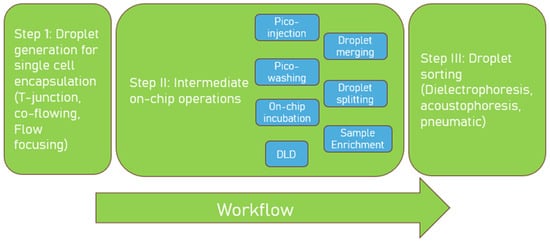
Figure 1
Open AccessArticle
Gaseous Ammonia Sensing from Liquids via a Portable Chemosensor with Signal Correction for Humidity
by
Andrea Rescalli, Ilaria Porello, Pietro Cerveri and Francesco Cellesi
Biosensors 2025, 15(7), 407; https://doi.org/10.3390/bios15070407 - 25 Jun 2025
Abstract
Ammonia (NH3) detection in liquids and biological fluids is essential for monitoring environmental contamination and industrial processes, ensuring food safety, and diagnosing health conditions. Existing detection techniques are often unsuitable for point-of-care (POC) use due to limitations including complex sample handling,
[...] Read more.
Ammonia (NH3) detection in liquids and biological fluids is essential for monitoring environmental contamination and industrial processes, ensuring food safety, and diagnosing health conditions. Existing detection techniques are often unsuitable for point-of-care (POC) use due to limitations including complex sample handling, lack of portability, and poor compatibility with miniaturized systems. This study introduces a proof-of-concept for a compact, portable device tailored for POC detection of gaseous ammonia released from liquid samples. The device combines a polyaniline (PANI)-based chemoresistive sensor with interdigitated electrodes and a resistance readout circuit, enclosed in a gas-permeable hydrophobic membrane that permits ammonia in the vapor phase only to reach the sensing layer, ensuring selectivity and protection from liquid interference. The ink formulation was optimized. PANI nanoparticle suspension exhibited a monomodal, narrow particle size distribution with an average size of 120 nm and no evidence of larger aggregates. A key advancement of this device is its ability to limit the impact of water vapor, a known source of interference in PANI-based sensors, while maintaining a simple sensor design. A tailored signal processing strategy was implemented, extracting the slope of resistance variation over time as a robust metric for ammonia quantification. The sensor demonstrated reliable performance across a concentration range of 1.7 to 170 ppm with strong logarithmic correlation (R2 = 0.99), and very good linear correlations in low (R2 = 0.96) and high (R2 = 0.97) subranges. These findings validate the feasibility of this POC platform for sensitive, selective, and practical ammonia detection in clinical and environmental applications.
Full article
(This article belongs to the Section Biosensor and Bioelectronic Devices)
►▼
Show Figures
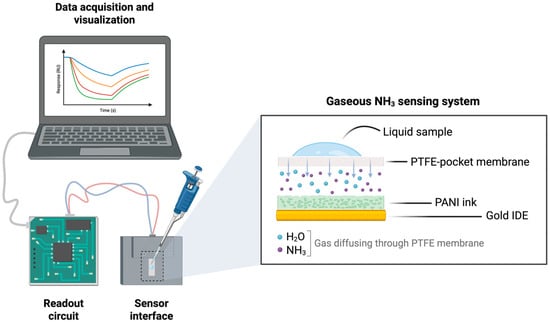
Figure 1
Open AccessArticle
Photoplethysmography Feature Extraction for Non-Invasive Glucose Estimation by Means of MFCC and Machine Learning Techniques
by
Christian Salamea-Palacios, Melissa Montalvo-López, Raquel Orellana-Peralta and Javier Viñanzaca-Figueroa
Biosensors 2025, 15(7), 408; https://doi.org/10.3390/bios15070408 - 24 Jun 2025
Abstract
Diabetes Mellitus is considered one of the most widespread diseases in the world. Traditional glucose monitoring devices carry discomfort and risks associated with the frequent extraction of blood from users. The present article proposes a noninvasive glucose estimation system based on the application
[...] Read more.
Diabetes Mellitus is considered one of the most widespread diseases in the world. Traditional glucose monitoring devices carry discomfort and risks associated with the frequent extraction of blood from users. The present article proposes a noninvasive glucose estimation system based on the application of Mel Frequency Cepstral Coefficients (MFCCs) for the characterization of photoplethysmographic signals (PPG). Two variants of the MFCC feature extraction methods are evaluated along with three machine learning techniques for the development of an effective regression function for the estimation of glucose concentration. A comparison between the performance of the algorithms revealed that the best combination achieved a mean absolute error of 9.85 mg/dL and a correlation of 0.94 between the estimated concentration and the real glucose values. Similarly, 99.53% of the validation samples were distributed within zones A and B of the Clarke Error Grid Analysis. The proposed system achieves levels of correlation comparable to analogous technologies that require earlier calibration for its operation, which indicates a strong potential for the future use of the algorithm as an alternative to invasive monitoring devices.
Full article
(This article belongs to the Section Wearable Biosensors)
►▼
Show Figures
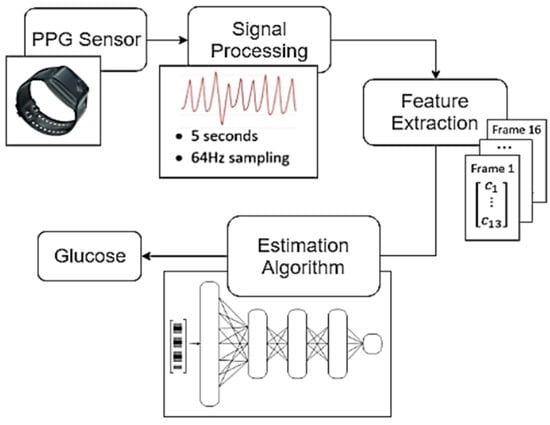
Figure 1
Open AccessArticle
Noninvasive Continuous Glucose Monitoring Using Multimodal Near-Infrared, Temperature, and Pressure Signals on the Earlobe
by
Jongdeog Kim, Bong Kyu Kim, Mi-Ryong Park, Hyoyoung Cho and Chul Huh
Biosensors 2025, 15(7), 406; https://doi.org/10.3390/bios15070406 - 24 Jun 2025
Abstract
This study investigates a noninvasive continuous glucose monitoring (NI-CGM) system optimized for earlobe application, leveraging the site’s anatomical advantages—absence of bone, muscle, and thick skin—for enhanced optical transmission. The system integrates multimodal sensing, combining near-infrared (NIR) diffuse transmission with temperature and pressure sensors.
[...] Read more.
This study investigates a noninvasive continuous glucose monitoring (NI-CGM) system optimized for earlobe application, leveraging the site’s anatomical advantages—absence of bone, muscle, and thick skin—for enhanced optical transmission. The system integrates multimodal sensing, combining near-infrared (NIR) diffuse transmission with temperature and pressure sensors. A novel Multi-Wavelength Slope Efficiency Near-Infrared Spectroscopy (MW-SE-NIRS) method is introduced, enhancing noise robustness through the slope efficiency-based parameterization of NIR signal dynamics. By employing three NIR wavelengths with distinct scattering and absorption properties, the method improves glucose detection reliability, addressing tissue heterogeneity and physiological noise in noninvasive monitoring. To validate the feasibility, a pilot clinical trial enrolled five participants with normal or pre-diabetic glucose profiles. Continuous glucose data capturing pre- and postprandial variations were analyzed using a 1D convolutional neural network (Conv1D). For three subjects under stable physiological conditions, the model achieved 97.0% Clarke error grid (CEG) A-Zone accuracy and a mean absolute relative difference (MARD) of 5.2%. Across all participants, results showed 90.9% CEG A-Zone accuracy and a MARD of 8.4%, with performance variations linked to individual factors such as earlobe thickness variability and physical activity. These outcomes demonstrate the potential of the MW-SE-NIRS system for noninvasive glucose monitoring and highlight the importance of future work on personalized modeling, sensor optimization, and larger-scale clinical validation.
Full article
(This article belongs to the Special Issue Advances in Glucose Biosensors Toward Continuous Glucose Monitoring)
►▼
Show Figures

Figure 1
Open AccessArticle
Flexible Hydrophobic Paper-Based Microfluidic Field-Effect Biosensor Amplified by RNA-Cleaving DNAzyme-Based DNA Nanostructure for Mg2+ Detection
by
Hui Wang, Yue He, Zhixue Yu, Ruipeng Chen, Zemeng Feng, Dongfei Chen, Waleid Mohamed El-Sayed Shakweer, Fan Zhang, Xuemei Nan, Mukaddas Mijit, Benhai Xiong, Liang Yang and Xiangfang Tang
Biosensors 2025, 15(7), 405; https://doi.org/10.3390/bios15070405 - 24 Jun 2025
Abstract
Magnesium ions (Mg2+) play an important role in animal health, with their concentration in the bloodstream serving as a key indicator for hypomagnesemia diagnosis. In this study, a flexible hydrophobic paper-based microfluidic field-effect biosensor was developed for point-of-care Mg2+ detection,
[...] Read more.
Magnesium ions (Mg2+) play an important role in animal health, with their concentration in the bloodstream serving as a key indicator for hypomagnesemia diagnosis. In this study, a flexible hydrophobic paper-based microfluidic field-effect biosensor was developed for point-of-care Mg2+ detection, which integrated flexible hydrophobic paper, semiconducting single-walled carbon nanotubes (SWNTs) and a Mg2+-specific RNA-cleaving DNAzyme(RCD)-based DNA nanostructure. Flexible hydrophobic paper was synthesized by using cellulose paper and octadecyltrichlorosilane, improving mechanical strength and decreasing biological interference. To achieve high sensitivity, the Mg2+-specific RCD was functionalized with SWNTs, and then repeatedly self-assembled two different Y-shaped DNAs to construct a DNA nanostructure based on a similar DNA origami technique. This proposed biosensor exhibited a linear detection range from 1 μM to 1000 μM, with a detection limit of 0.57 μM, demonstrating its great stability, selectivity, and anti-interference performance. This innovative design offers promising potential for Mg2+ monitoring in real applications.
Full article
(This article belongs to the Special Issue Design and Application of Microfluidic Biosensors in Biomedicine)
►▼
Show Figures
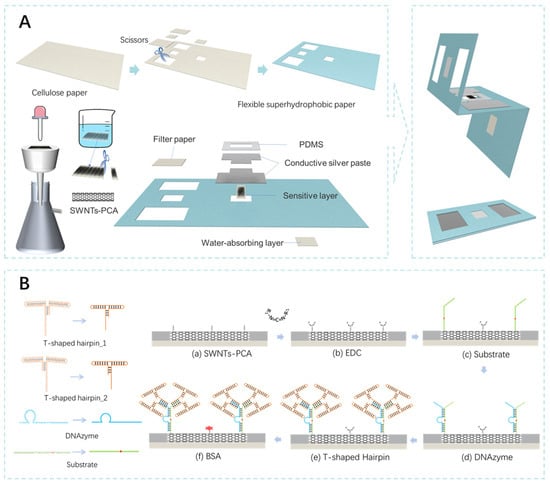
Figure 1
Open AccessArticle
Whole-Cell Fiber-Optic Biosensor for Real-Time, On-Site Sediment and Water Toxicity Assessment: Applications at Contaminated Sites Across Israel
by
Gal Carmeli, Abraham Abbey Paul, Kathelina Kristollari, Evgeni Eltzov, Albert Batushansky and Robert S. Marks
Biosensors 2025, 15(7), 404; https://doi.org/10.3390/bios15070404 - 22 Jun 2025
Abstract
Sediments are key players in the optimum functioning of ecosystems; however, they also represent the largest known repository of harmful contaminants. The vast variety of these sediment-associated contaminants may exert harmful effects on marine communities and can impair ecosystem functioning. Whole-cell biosensors are
[...] Read more.
Sediments are key players in the optimum functioning of ecosystems; however, they also represent the largest known repository of harmful contaminants. The vast variety of these sediment-associated contaminants may exert harmful effects on marine communities and can impair ecosystem functioning. Whole-cell biosensors are a rapid and biologically relevant tool for assessing environmental toxicity. Therefore, in this study, we developed a bioassay-based toxicity measurement system using genetically modified bacteria to create a whole-cell optical biosensor. Briefly, reporter bacteria were integrated and immobilized using a calcium alginate matrix on fiber-optic tips connected to a photon counter placed inside a light-proof, portable case. The calcium alginate matrix acts as a semi-permeable membrane that protects the reporter-encapsulated optical fiber tips and allows the inward passage of toxicant(s) to induce a dose-dependent response in the bioreporter. The samples were tested by directly submerging the fiber tip with immobilized bacteria into vials containing either water or suspended sediment samples, and the subsequent bioluminescent responses were acquired. In addition to bioavailable sediment toxicity assessments, conventional chemical methods, such as liquid chromatography–mass spectroscopy (LC-MS) and inductively coupled plasma optical emission spectroscopy (ICP-OES), were used for comprehensive evaluation. The results demonstrated the efficacy of the biosensor in detecting various toxicity levels corresponding to identified contaminants, highlighting its potential integration into environmental monitoring frameworks for enhanced sediment and water quality assessments. Despite its utility, this study notes the system’s operational challenges in field conditions, recommending future enhancements for improved portability and usability in remote locations.
Full article
(This article belongs to the Special Issue Optical Biosensors for Environmental Monitoring)
►▼
Show Figures

Figure 1
Open AccessArticle
Enhancing Biomarker Detection and Imaging Performance of Smartphone Fluorescence Microscopy Devices
by
Muhammad Ahsan Sami, Muhammad Nabeel Tahir and Umer Hassan
Biosensors 2025, 15(7), 403; https://doi.org/10.3390/bios15070403 - 21 Jun 2025
Abstract
Fluorescence microscopy enabled by smartphone-coupled 3D instruments has shown utility in different biomedical applications ranging from diagnostics to biomanufacturing. Recently, we have designed and developed these devices and have demonstrated their utility in micro-nano particle sensing and leukocyte imaging. Here, we present a
[...] Read more.
Fluorescence microscopy enabled by smartphone-coupled 3D instruments has shown utility in different biomedical applications ranging from diagnostics to biomanufacturing. Recently, we have designed and developed these devices and have demonstrated their utility in micro-nano particle sensing and leukocyte imaging. Here, we present a novel application for enhancing the imaging performance of smartphone fluorescence microscopes (SFM) and reducing their operational complexity. Computational noise correction is employed using 3D Averaging and 3D Gaussian filters of different kernel sizes (3 × 3 × 3, 7 × 7 × 7, 11 × 11 × 11, 15 × 15 × 15, and 21 × 21 × 21) and various standard deviations σ (for Gaussian only). Fluorescent beads of different sizes (8.3, 2, 1, 0.8 µm) were imaged using a custom-designed SFM. The application of the computational filters significantly enhanced the signal quality of particle detection in the captured fluorescent images. Amongst the Averaging filters, a kernel size of 21 × 21 × 21 produced the best results for all bead sizes, and similarly, amongst Gaussian filters, σ equal to 5 and a kernel size equal to 21 × 21 × 21 produced the best results. This visual improvement was then quantified by calculating the signal-difference-to-noise ratio (SDNR) and contrast-to-noise ratio (CNR) of filtered and unfiltered original images using a custom-developed quality assessment algorithm (AQAFI). Lastly, noise correction using Averaging and Gaussian filters with the previously identified optimal parameters was applied to images of fluorescently tagged human peripheral blood leukocytes captured using an SFM under various conditions. The ubiquitous nature and simplistic application of these filters enable their utility with a range of existing fluorescence microscope designs, thus allowing us to enhance their imaging capabilities.
Full article
(This article belongs to the Special Issue Cell-Based Biosensors for Rapid Detection and Monitoring (2nd Edition))
►▼
Show Figures
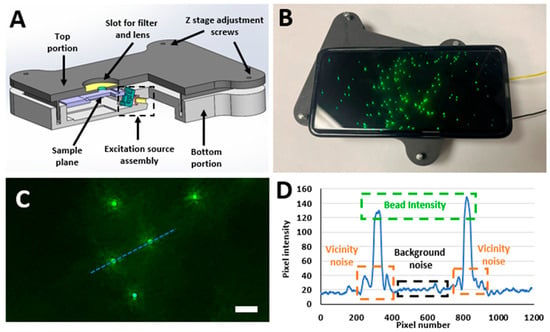
Figure 1
Open AccessReview
Electrochemical Aptamer-Based Biosensors for Sepsis Diagnosis: Recent Advances, Challenges, and Future Perspectives (2020–2025)
by
Ling Ling Tan and Nur Syamimi Mohamad
Biosensors 2025, 15(7), 402; https://doi.org/10.3390/bios15070402 - 20 Jun 2025
Abstract
Sepsis remains a global health emergency, demanding timely and accurate diagnostics to reduce morbidity and mortality. This review critically assesses the recent progress (2020–2025) in the development of electrochemical aptamer-based biosensors for sepsis detection. These biosensors combine aptamers’ high specificity and modifiability with
[...] Read more.
Sepsis remains a global health emergency, demanding timely and accurate diagnostics to reduce morbidity and mortality. This review critically assesses the recent progress (2020–2025) in the development of electrochemical aptamer-based biosensors for sepsis detection. These biosensors combine aptamers’ high specificity and modifiability with the sensitivity and miniaturization potential of electrochemical platforms. The analysis highlights notable advances in detecting key sepsis biomarkers, such as C-reactive protein (CRP), procalcitonin (PCT), interleukins (e.g., interleukin-6 (IL-6), tumor necrosis factor-alpha (TNF-α)), lipopolysaccharides (LPSs), and microRNAs using diverse sensor configurations, including a field-effect transistor (FET), impedance spectroscopy, voltammetry, and hybrid nanomaterial-based systems. A comparative evaluation reveals promising analytical performance in terms of the limit of detection (LOD), rapid response time, and point-of-care (POC) potential. However, critical limitations remain, including variability in validation protocols, limited testing in real clinical matrices, and challenges in achieving multiplexed detection. This review underscores translational barriers and recommends future directions focused on clinical validation, integration with portable diagnostics, and interdisciplinary collaboration. By consolidating current developments and gaps, this work provides a foundation for guiding next-generation biosensor innovations aimed at effective sepsis diagnosis and monitoring.
Full article
(This article belongs to the Section Biosensor and Bioelectronic Devices)
►▼
Show Figures
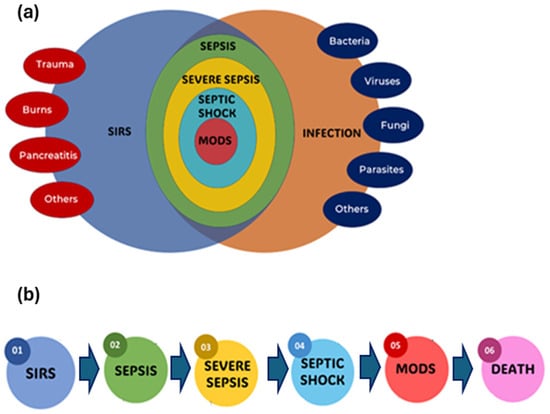
Figure 1
Open AccessReview
Plasmonic and Dielectric Metasurfaces for Enhanced Spectroscopic Techniques
by
Borja García García, María Gabriela Fernández-Manteca, Dimitrios C. Zografopoulos, Celia Gómez-Galdós, Alain A. Ocampo-Sosa, Luis Rodríguez-Cobo, José Francisco Algorri and Adolfo Cobo
Biosensors 2025, 15(7), 401; https://doi.org/10.3390/bios15070401 - 20 Jun 2025
Abstract
Spectroscopic techniques such as Surface-Enhanced Raman Scattering (SERS), Surface-Enhanced Infrared Absorption (SEIRA), and Surface-Enhanced Fluorescence (SEF) are essential analytical techniques used to study the composition of materials by analyzing the way materials scatter light, absorb infrared radiation or emit fluorescence signals. This provides
[...] Read more.
Spectroscopic techniques such as Surface-Enhanced Raman Scattering (SERS), Surface-Enhanced Infrared Absorption (SEIRA), and Surface-Enhanced Fluorescence (SEF) are essential analytical techniques used to study the composition of materials by analyzing the way materials scatter light, absorb infrared radiation or emit fluorescence signals. This provides information about their molecular structure and properties. However, traditional SERS, SEIRA, and SEF techniques can be limited in sensitivity, resolution, and reproducibility, hindering their ability to detect and analyze trace amounts of substances or complex molecular structures. Metasurfaces, a class of engineered two-dimensional metamaterials with unique optical properties, have emerged as a promising tool to overcome these limitations and enhance spectroscopic techniques. This article provides a state-of-the-art overview of metasurfaces for enhanced SERS, SEIRA and SEF, covering their theoretical background, different types, advantages, disadvantages, and potential applications.
Full article
(This article belongs to the Special Issue Photonics for Bioapplications: Sensors and Technology—2nd Edition)
►▼
Show Figures

Figure 1

Journal Menu
► ▼ Journal Menu-
- Biosensors Home
- Aims & Scope
- Editorial Board
- Reviewer Board
- Topical Advisory Panel
- Instructions for Authors
- Special Issues
- Topics
- Sections & Collections
- Article Processing Charge
- Indexing & Archiving
- Editor’s Choice Articles
- Most Cited & Viewed
- Journal Statistics
- Journal History
- Journal Awards
- Conferences
- Editorial Office
Journal Browser
► ▼ Journal BrowserHighly Accessed Articles
Latest Books
E-Mail Alert
News
Topics
Topic in
Analytica, Molecules, Nanomaterials, Polymers, Magnetochemistry, Biosensors
Nanomaterials in Green Analytical Chemistry
Topic Editors: George Zachariadis, Rosa Peñalver, Natalia ManousiDeadline: 15 August 2025
Topic in
Applied Sciences, Biosensors, Chips, Micromachines, Molecules
Advances in Microfluidics and Lab on a Chip Technology, 2nd Edition
Topic Editors: Roman Grzegorz Szafran, Yi YangDeadline: 31 August 2025
Topic in
Applied Sciences, Biosensors, Designs, Electronics, Materials, Micromachines, Applied Biosciences
Wearable Bioelectronics: The Next Generation of Health Insights
Topic Editors: Shuo Gao, Yu Wu, Wenyu WangDeadline: 31 March 2026
Topic in
Applied Nano, Biosensors, Materials, Nanomaterials, Chemosensors, Applied Biosciences, Laboratories
Applications of Nanomaterials in Biosensing: Current Trends and Future Prospects
Topic Editors: Kundan Sivashanmugan, Xianming KongDeadline: 30 April 2026

Conferences
Special Issues
Special Issue in
Biosensors
Advanced Bioelectronics for Healthcare Monitoring and Disease Diagnosis
Guest Editors: Xingcan Huang, Jiyu Li, Kuanming Yao, Sancan HanDeadline: 15 July 2025
Special Issue in
Biosensors
Functionalized Probes for Bioimaging and Biosensing
Guest Editor: Yalin QiDeadline: 15 July 2025
Special Issue in
Biosensors
CRISPR/Cas-Based Biosensing Systems: Development and Applications—2nd Edition
Guest Editor: Ki Soo ParkDeadline: 20 July 2025
Special Issue in
Biosensors
Recent Advances in Glucose Biosensors
Guest Editors: Natalija German, Anton PopovDeadline: 25 July 2025
Topical Collections
Topical Collection in
Biosensors
Novel Sensing System for Biomedical Applications
Collection Editors: Chia-Ching Chang, Chiun-Jye Yuan, Chih-Chia Huang
Topical Collection in
Biosensors
Microsystems for Cell Cultures
Collection Editors: Iordania Constantinou, Thomas E. Winkler








